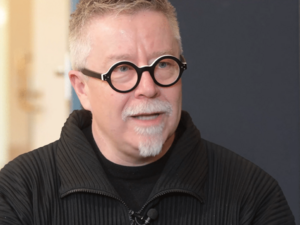IDEO facts for kids
 |
|
| Private | |
| Industry | Design firm |
| Founded | 1991, with the merging of David Kelley Design (est 1978), Moggridge Associates (est 1969), ID Two (est 1979), and Matrix Product Design (est 1983). |
| Founders | David Kelley Bill Moggridge Mike Nuttall |
| Headquarters | San Francisco, California |
|
Key people
|
|
|
Number of employees
|
500+ (2023) |
IDEO (pronounced "eye-dee-oh") is a company that helps design new products, services, and experiences. They have offices in the United States, England, and China. IDEO was started in Palo Alto, California, in 1991.
The company has over 500 employees. They use a special way of thinking called "design thinking." This helps them create many different things. These include products, services, places, brands, and digital tools.
In 1996, a company called Steelcase bought most of IDEO. But IDEO still worked on its own. By the early 2000s, IDEO also started helping companies with how they are run. In 2016, a Japanese company called Kyu Collective bought a part of IDEO. Steelcase still owned a small part too.
Contents
How IDEO Started
IDEO was formed in 1991. It was created by joining four different design companies. These companies were David Kelley Design, Moggridge Associates, ID Two, and Matrix Product Design.
David Kelley Design was started by David M. Kelley, a professor from Stanford University. Moggridge Associates and ID Two were started by Bill Moggridge. Matrix Product Design was started by Mike Nuttall.
Early Designs and Growth
Before IDEO was formed, David Kelley's company worked on important designs. They helped design the computer mice for the Apple Lisa and the first original Apple Macintosh computers.
In 1996, Steelcase, a company that makes office furniture, bought most of IDEO. IDEO kept working independently. Steelcase later started selling its shares of IDEO in 2007. By the early 2000s, IDEO began to help companies with their management and how they are organized. In 2016, a Japanese company called Kyu Collective bought a part of IDEO.
At first, IDEO mostly designed products like toothbrushes or computers. But by 2001, they started to focus more on how people experience things and on designing services.
In 2011, IDEO helped start IDEO.org. This is a non-profit group that helps people in communities that need it most.
In April 2019, Sandy Speicher became the CEO of IDEO.
In November 2022, the company announced that Derek Robson would become CEO starting January 5, 2023.
The Shopping Cart Challenge
On February 9, 1999, a TV show called Nightline showed IDEO in a special segment. It was called The Deep Dive: One Company's Secret Weapon for Innovation.
In the show, a reporter challenged IDEO to redesign a shopping cart in just five days. This was to show how IDEO comes up with new ideas. The new shopping cart had a steel frame and plastic baskets that could be removed. This helped stop theft and made shopping easier. It also had a double seat for kids with a tray, a cup holder, and a barcode reader to skip checkout lines. The back wheels could also steer, making it easier to move. This TV segment is now used in many schools and universities to teach about innovation.
Working Together
On October 17, 2017, IDEO bought a company called Datascope. Datascope is a data science company from Chicago. Datascope had worked with IDEO on many projects before. Tim Brown, who is the Chair of IDEO, said that buying Datascope was important because of new ideas in data science. These new ideas help IDEO focus more on designing things for people. Datascope's team of 15 people moved to IDEO's Chicago office.
Since IDEO was bought by Kyu, it often works with other companies that are part of the Kyu group.
How IDEO Works
IDEO has a special way of working. They use project teams, and everyone's ideas are important. People can work on their own ideas, and they work together a lot. The company has over 500 employees. These employees have many different skills. Some of these skills include: understanding how people behave, branding, business design, communication design, and research. They also have experts in digital design, education, engineering, food science, healthcare, and industrial design.
What IDEO Designs
IDEO has worked on projects for many different industries. These include food and drinks, retail, computers, medicine, education, furniture, offices, and cars.
Some examples of their work include Apple's first mouse, the Palm V PDA, and Steelcase's Leap chair. They have worked with many clients. Some of these are Air New Zealand, Coca-Cola, ConAgra Foods, Eli Lilly, Ford, and Steelcase.
Solving Problems Together Online
In August 2010, IDEO launched OpenIDEO. This is an online platform where people can work together on design projects. OpenIDEO was first made for IDEO to work with its clients. But now, it is open to everyone. The goal is to help people from different backgrounds work together online to solve social problems.
For example, OpenIDEO has helped with projects for the WWF. It also helped with Jamie Oliver's Food Revolution movement. In another project, they worked with Sutter Health to "reimagine the end of life experience." This led to new international projects called End Well and Re:imagine.
Learning Design Thinking
IDEO U is an online learning program that started in early 2015. In these courses, people learn about "human-centered design thinking." This means designing things by focusing on what people need.
Besides the online program, IDEO and its partners have written several books about design thinking. One popular book is Creative Confidence: Unleashing the Creative Potential Within Us All. Tim Brown, a former CEO, wrote Change by Design: How Design Thinking Transforms Organizations and Inspires Innovation (2009). In his book, he explains how design can turn problems into chances to create something new. He emphasizes that design thinking is about understanding people. He especially values "empathy," which means designers try to understand the problems that users face.





